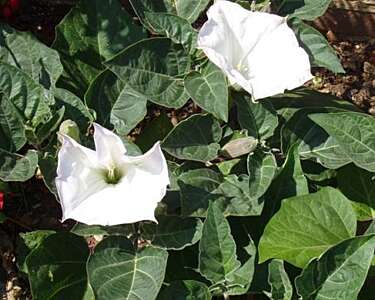Thorn-apple

Other names
Jimsonweed, thornapple
Latin names
Datura stramonium L. (D. inermis, D. tatula)
Weed Type
Annual Broad-leaved Weeds
Where would I find Thorn-apple?
Thorn-apple is an introduced annual weed of cultivated fields, gardens and waste places with a large prickly fruit that gives the plant its name. It is a casual from several sources including birdseed and wool and soybean waste. Thorn-apple occurs sporadically throughout the UK particularly in hot summers. The large trumpet-like flowers are usually white but var. chalybaea has purple flowers.
The plant is poisonous to humans, horses, cattle, sheep, pigs, mules and chickens. Livestock normally avoid it but may be poisoned by eating contaminated hay, silage or seed screenings. Toxicity varies with growing conditions. Thorn-apple has restricted medicinal uses. In Japan, it has been found that an extract of thorn-apple can halt the growth of certain types of brain tumour.
Biology
Thorn-apple flowers from July to October. Seeds mature 30 days after pollination and the seed capsule opens 20 days later. There may be 50 or more capsules per plant, 600-700 seeds per capsule and around 30,000 seeds per plant. Seeds will continue to ripen in capsules on cut down plants. Seeds taken from a partly green capsule that turn black on drying are fully viable. Immature seeds are said to germinate more readily than fully mature seed.
Dead ripe seed may germinate immediately after shedding but the majority soon becomes dormant. The low germination rates are put down to many factors including an impermeable seedcoat. A short soak or rinse in water causes the tissue within the hilum to swell, restricting oxygen uptake and inhibiting subsequent germination. Cracking or chipping the seed coat allows germination to take place.
Burial of seed increases the light requirement for germination to occur. Sensitivity to light and the effect of gaseous diffusion in the soil around the seed allow it to perceive the proximity of the soil surface. Cultivation triggers seedling emergence by the removal of volatile dormancy-inducing metabolites and the exposure of seeds to light. Reburial of seed before germination re-imposes dormancy. In the field, seedling emergence occurred from May to August with peak emergence in May. After emergence, seedlings establish and grow rapidly to shade out surrounding vegetation.
Thorn-apple is a C3 plant in terms of carbon fixation during photosynthesis.
Does Thorn-apple spread easily?
Seeds buried 34 cm deep in soil for 39 years were still capable of 91% germination. The viability of seed buried 8 cm deep remained high for 30 years but then appeared to decrease. Seed in the surface layers of soil decayed faster but viable seeds were still present after 3 years. In dry storage, seed gave 43% germination after 5 years but had lost viability after 15 years.
Mature seeds are dispersed 1-3 m from the parent plant by dehiscence of the seed capsule. This can be stimulated by disturbance of the plant foliage. The capsule and seeds are buoyant in water and can remain floating for 10 or more days. Seeds submerged in water for 6 months still gave 21% germination. The seeds may also be dispersed on farm machinery or as an impurity in crop seeds.
How to manage Thorn-apple organically
Small patches should be hand pulled before seed is set. Seedlings are readily killed by tillage. Older plants may regenerate from cut down stumps.
In the USA, the beetle (Lema trivittata) causes severe defoliation of thorn-apple and reduces seed production. The fungus Alternaria crassahas been evaluated as a potential biocontrol agent. Thorn-apple seed is moderately susceptible to soil solarization.
A model that simulates population growth following the introduction of thorn-apple, predicts that without adequate control the weed will build up to a high level in 5-6 years.
Thanks to John Vernon for the photograph.